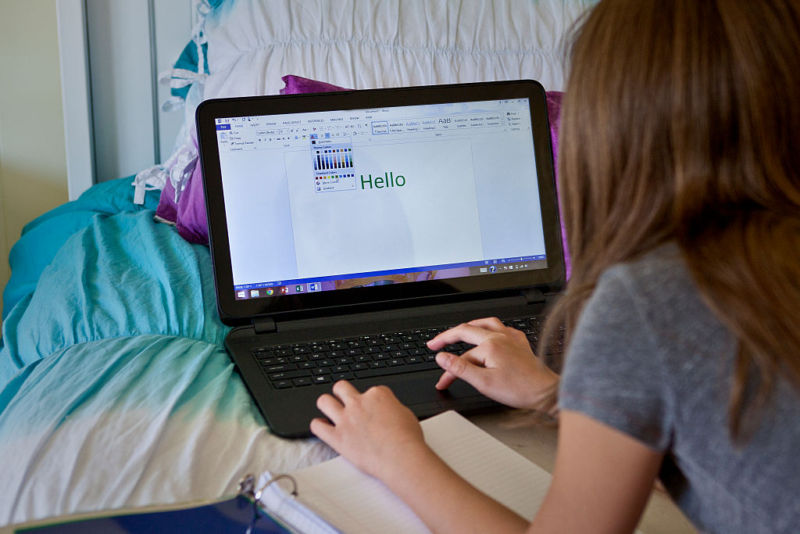
I can’t put my hands on the thing right now, but I’m pretty sure that the Parenting Manual I was issued when my kids were born deemphasized the importance of keeping up with changes in the way they do things as they grow up. The worksheets and hand-written essays of their younger years have changed into collaborative work done online as they “matured” into high-schoolers.
Has it changed the work? Maybe less than it first appears. Technology may change human behavior, but it doesn’t really change human nature. Most kids don’t much like doing homework, and cloud services haven’t done a lot to change that. What’s interesting is that the kids, teachers, and administrators I talked to generally like the flexibility of using cloud-based classroom tools, but none of them think it has fundamentally changed classroom life.
Why can’t we see your homework?
My two boys are sophomores at the Institute of Collaborative Education, a public New York City middle/high school with about 80 kids in each of the six grades. ICE puts most of its educational emphasis on project work; the kids have a fairly major project to complete for each class in each quarter, many of them collaborating with either a small group or with their class as a whole within a cloud environment.
One of the results is that my wife and I—who, while we for many years have not so much scrutinized every piece of homework as just tried to make sure that assignments were at least done—haven’t seen anything they’ve handed in for years. This, frankly, makes us uncomfortable. But in an age of online homework, it’s a discomfort we’ll probably have to just get over.
In separate interviews—and they really were interviews and not interrogations—the boys claimed that this is not the result of 15-year-old boys naturally hiding their business from their parents. It’s just, as Michael told me, that it’s simpler to do something on the computer, upload it to their Google Drive, and click Share with their teachers.
Jeremy, his brother, noted that Google Docs keeps track of who did what on a shared document, and when. When a grade depends in part on what group member contributed how much (and whether the group did things over time or crammed it into the last evening before the deadline), that kind of accountability is important.
But this process raises a question: what happens to the collaborative electronic work style when maybe not everyone has a computer at home?
“It’s definitely something I need to be aware of,” said Jennifer Dahlstrom, a science teacher at ICE. “I can’t require students to collaborate on a document for homework if I know there are students who won’t have reliable Wi-Fi that night.”
Out of 50 kids in her section, she said, maybe 10 percent have trouble connecting outside the classroom. “The number’s getting smaller,” she said, “because there’s functionality on the phone. Almost all of them have smartphones. At the high school level, almost 99 percent.”
Michael Rosenbaum reports that ICE, being a typically resource-constrained New York City public school, has roughly one (Windows) laptop for every two kids. So the kids share in the classroom, and more than a few bring their own computer.
Accountability and accessibility in the cloud
Bonnie Robinson is the director of curriculum, instruction, and assessment for Lebanon High School in Lebanon, New Hampshire. It’s a district that includes many kids of Dartmouth College faculty, but she said 20 percent of the students qualify for free or reduced-cost lunch. She says the digital divide isn’t much of a problem at her school. “We have Chromebooks, laptops, and desktop computers available in several locations at school,” she said. “Most have both computers and Internet access at home, but those few who do not manage to work around that challenge. All kids have smart phones, and these are used for many purposes—mostly social, but also for school work. Many students prefer to use their phones” rather than a larger device.
Robinson also said that the cloud-based classroom enforces accountability, because the students can always look up the assignment and get the resources to complete it. Tools like PowerSchool let parents track grades and completion of assignments, and ICE uses Jupitergrades for the same purpose.
With all this work getting done electronically, it would be reasonable to expect that it would allow the creation of a durable digital portfolio. That, however, seems to be a challenge yet to be surmounted. “We’re still developing digital portfolios,” said ICE’s Dalhstrom. “We haven’t found something that’s affordable that we’re happy with.” Instead, she said, kids store their work on their own Google Drive. Jeremy Rosenbaum says most of the work ultimately gets printed out anyway.
In Hancock, Robinson says that the school’s IT department disables students' accounts the August after they graduate, so they’re encouraged to download their work to their personal accounts.
As far as parental involvement goes, Dahlstrom agrees with my gut feeling. “I do have the feeling that they (parents) are not as involved,” she said. “Parents used to be able to go through their kids’ bags to see the work,” which is no longer an option.
But the ultimate question is this: the comfort and enthusiasm of parents, kids, teachers and administrators aside, does all this technology actually improve the educational result? “I think it’s a net positive,” Dalhstrom said. “Not a drastic net positive. It hasn’t changed my pedagogy. If it all disappeared, my class would still be fabulous.”
Dan Rosenbaum is a technology journalist who specializes in the intersection of technology and society.
reader comments
55